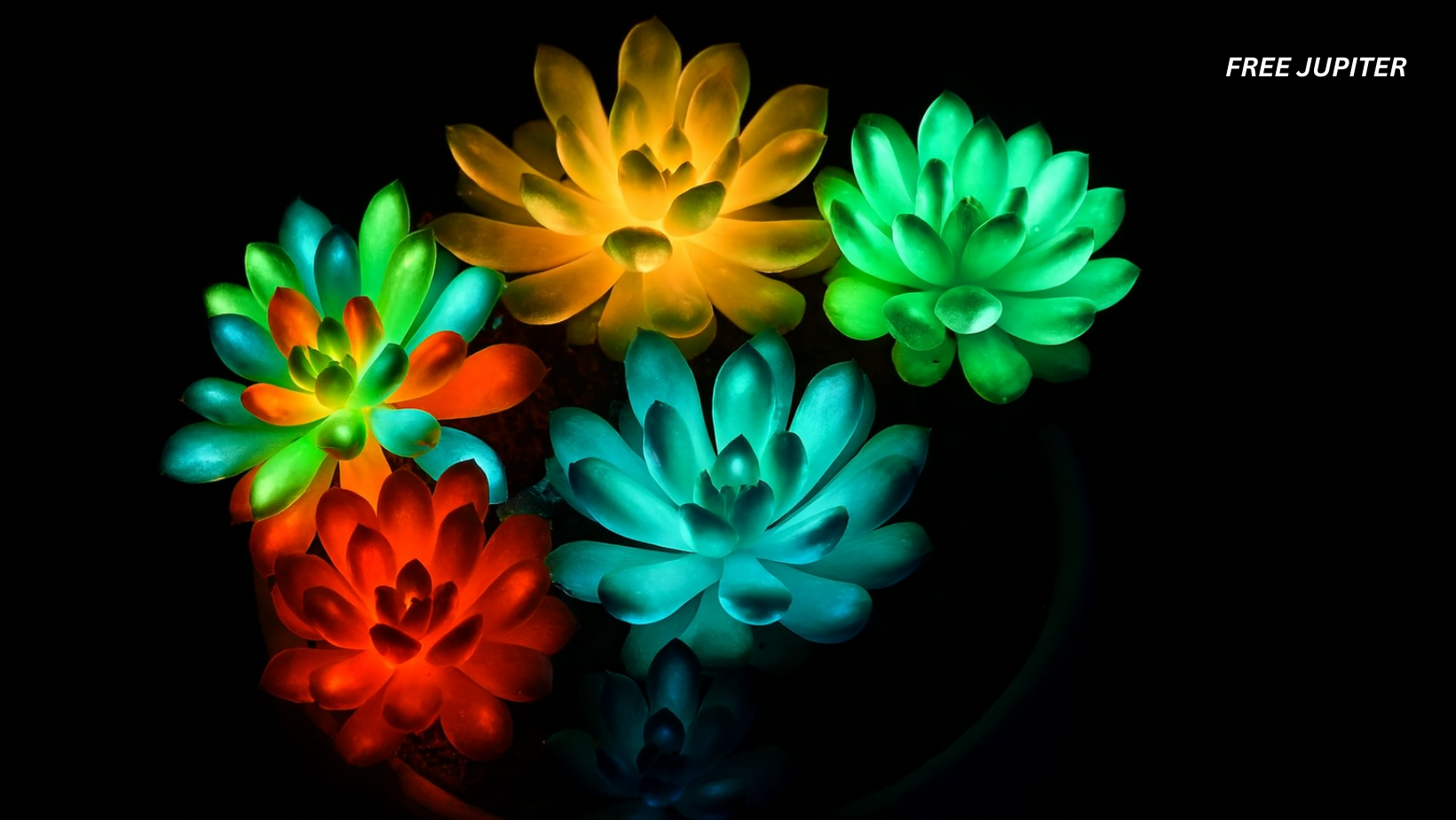Glow-in-the-dark plants bright enough to illuminate streets might sound like the opening scene of a futuristic movie. Picture wandering through a city where glowing trees replace streetlights, or imagine sitting in a park where flowers shimmer in neon colors instead of being lit by artificial bulbs. While this vision seems straight out of fantasy or science fiction, researchers are already taking small but impressive steps toward making it a reality.
Scientists in China recently unveiled something remarkable: multicolored, rechargeable glow-in-the-dark succulent plants. These plants don’t just give off a soft greenish shimmer like some of the earlier experiments; instead, they can shine in red, blue, and green, making them the brightest glowing plants ever created.
This breakthrough raises exciting possibilities—and a fair share of skepticism. Could plants really become the streetlamps of the future? Or will they remain a quirky novelty, more at home on someone’s windowsill than lining a city street?
From Sci-Fi Dream to Scientific Reality
Bioluminescence—the natural ability to glow—has fascinated humans for centuries. Fireflies lighting up summer nights, deep-sea creatures shimmering in darkness, and glowing fungi on forest floors all show that nature already has its own form of “living light.”
But what scientists are doing with plants is different. Instead of relying on genes from glowing organisms, researchers are now turning to materials that can absorb and release light energy.
As biologist Shuting Liu from South China Agricultural University explained, the inspiration came from a mixture of science and imagination:
“Think of the world of Avatar, where glowing plants illuminate an entire ecosystem. We wanted to make that vision possible using materials we already work with in the lab. Imagine glowing trees replacing streetlights.”
This dream led Liu and her team to experiment with a popular succulent known as Echeveria “Mebina.”
How Do Glow-in-the-Dark Succulents Work?
The secret ingredient is strontium aluminate, a material you’ve probably encountered before without realizing it. It’s the same stuff used in glow-in-the-dark toys, stickers, and emergency exit signs.
Here’s how it works:
- Charging with Light – The material absorbs energy from a light source, usually sunlight or a lamp.
- Storing Energy – That energy gets locked into the structure of the material.
- Releasing the Glow – Slowly, the material releases the stored energy in the form of visible light, which we perceive as a glow.
The researchers injected tiny particles of strontium aluminate—called nanoparticles—into the leaves of the succulent. Unlike earlier methods, which involved genetic modification, this approach let them bypass DNA tinkering and instead create a direct light-storage system within the plant itself.
And here’s the exciting twist: instead of just glowing green (the usual limit for genetically modified glowing plants), these succulents could shine in red, blue, and green.
Breaking Away from Gene Editing
Before this study, most attempts at glowing plants relied on borrowing genes from naturally bioluminescent organisms, like fireflies or certain fungi. While effective, the glow was usually faint and restricted to shades of green.
Liu’s team took a different approach. By embedding inorganic particles into the plant rather than editing its DNA, they unlocked brighter and multicolored effects.
Liu explained it as creating a photosynthesis-independent light system. In other words, instead of relying on a plant’s natural biological processes, the plant is given an add-on system that works like a rechargeable battery—soaking up light during the day and glowing at night.
The result? A plant that functions almost like a natural lamp.
Read more: Scientists Create Plastic From Grapevine Waste That Breaks Down in Only 17 Days
Putting Glow to the Test
To demonstrate their creation, the researchers built a vertical “green wall” of 56 glowing succulents. Once exposed to sunlight for a few minutes, the wall gave off enough light for someone to read text or recognize small objects within four inches.
The afterglow lasted around two hours before fading. But the magic is that the plants can be recharged over and over again by simply returning them to sunlight. Even weeks later, they continued to glow when exposed to ultraviolet light—sometimes even from wilted leaves.
It’s not hard to imagine how these plants could one day be arranged into glowing pathways, ambient garden lights, or even luminous art installations.
The Challenge of Keeping Plants Healthy
Of course, injecting glowing materials into living plants isn’t without risks. Strontium aluminate can decompose inside plant tissue, potentially causing harm. To solve this, Liu’s team added a protective chemical coating around the particles, creating a barrier that kept both the plant and the glow safe.
This innovation allowed the succulents to keep glowing without losing their vitality. Still, the team admits the technology needs further refinement before it can be scaled up safely.
Could Glowing Plants Replace Streetlights?
The idea of “living streetlights” is undeniably enchanting. It conjures up images of eco-friendly cities glowing softly at night without relying on electricity.
However, not everyone believes this is achievable. John Carr, a plant science professor at the University of Cambridge who was not involved in the study, praised the creativity of the research but questioned its practicality:
“Because of the limited amount of energy that these plants can emit, I don’t really see them as streetlights anytime soon.”
And he’s not alone. Many experts argue that while the plants can glow, the brightness is nowhere near what’s needed to light up streets or large spaces.
Current Uses: Decoration Over Illumination
For now, Liu admits that the succulents are best suited for ornamental purposes—think glowing houseplants, ambient decor, or artistic displays.
They could serve as natural “night lights,” softening the atmosphere in homes, cafes, or gardens. Imagine a dinner party illuminated not by candles or bulbs, but by softly glowing plants scattered across the table.
It’s less about replacing practical lighting and more about adding a touch of wonder to everyday spaces.
The Bigger Picture: Why Glow-in-the-Dark Plants Matter
Even if they never replace streetlights, glowing plants represent a fascinating step in the blending of biology, technology, and design.
Here’s why this research is important:
- Sustainability – If improved, these plants could reduce the need for artificial lighting in certain settings, cutting energy consumption.
- Innovation in Materials – Using nanoparticles opens doors for combining living organisms with inorganic materials in new, eco-friendly ways.
- Public Engagement with Science – Glow-in-the-dark plants spark curiosity and excitement about science, making complex research accessible to everyday people.
A Future of Living Light?
Liu and her colleagues are optimistic. They believe that with further improvements, they could enhance the brightness and extend the glow duration. Safety tests are ongoing to ensure that both the plants and surrounding environments remain unharmed.
If successful, future generations might enjoy:
- Glowing gardens and parks that shimmer at night.
- Street trees that emit soft light for pedestrians.
- Indoor plants that double as natural lamps.
It’s a long road, and Liu admits the technology is “still far from functional illumination.” But like all scientific breakthroughs, this is just the beginning.
For now, these glowing succulents are less about practicality and more about possibility—a reminder that science can turn what once seemed like pure fantasy into something we can hold, nurture, and even decorate our homes with.
Read more: A Real-Life Pandora? Scientists Spot Possible Alien World Near Alpha Centauri A
Final Thought
Glow-in-the-dark plants may never fully replace streetlights, but they already shine as a symbol of human creativity. Whether they end up in homes as mood lighting or one day glow across city parks, they bring us closer to a world where nature itself becomes part of our light source.
And who knows? Maybe the future won’t be lit by neon signs or LED bulbs, but by glowing leaves and flowers swaying gently in the night breeze.
Featured image: GPT-5o Recreation.
Friendly Note: FreeJupiter.com shares general information for curious minds. Please fact-check all claims and double-check health info with a qualified professional. 🌱










